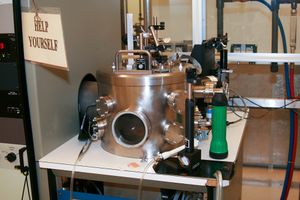RIE 3 (MRC): Difference between revisions
Created page with "{{tool|{{PAGENAME}} |picture=RIE2.jpg |type = Dry Etch |super= Brian Lingg |phone= 805-893-3918x210 |location=Bay 3 |email=lingg@ece.ucsb.edu |description = RIE #2 Methane / Hydr…" |
No edit summary |
||
| Line 13: | Line 13: | ||
= About = |
= About = |
||
This is a Materials Research Corporation RIE-51 parallel plate, 13.56 |
This is a Materials Research Corporation RIE-51 parallel plate, 13.56 MHz system used for etching with fluorine-containing gases (CF4, SF6, and CHF3). The system is used primarily for etching of Si, SiO<sub>2</sub>, and Si<sub>3</sub>N<sub>4</sub> films. Metals such as tungsten may also be etched. Tool features include: six inch diameter water cooled cathode/substrate platform, pyrex cylinder for plasma confinement and gas flow control, adjustable cathode-anode spacing, fixed DC bias or RF power control and a HeNe laser etch monitor with chart recorder. It is turbo pumped and has no loadlock. |
||
CF<sub>4</sub> / O<sub>2</sub> and SF<sub>6</sub> /O<sub>2</sub> will etch Si, SiO<sub>2</sub> and Si<sub>3</sub>N<sub>4</sub> readily since free fluorine is readily liberated in the plasma. The oxygen (up to 40%) initially enhances the fluorine concentration resulting in a higher etch rate. The oxygen also minimizes polymer formation in CF4/O<sub>2</sub>. Too much Oxygen will compete for fluorine available, suppressing the etch rate. Argon can be added to increase the physical component of etching. The highest etch rates are achieved with SF6 due to the ease of liberating fluorine compared with CF4. The relative etch rate decreases as one goes from Si to Si3N4 to SiO<sub>2</sub>. CF4/H<sub>2</sub> and CHF3 can be used to selectivity etch SiO2 over Si and resist due to increased polymer formation from the presence of hydrogen. This polymer layer is thicker on Si and resist than on SiO<sub>2</sub>. The trade-off is selectivity versus sidewall profile as the polymer will result in a tapered wall profile. Also, the polymer can be difficult to remove after etching. |
|||
RIE of InP and related compounds can be achieved with a hydride-based process chemistry of methane/hydrogen with an etching mechanism due to a "reverse" metalorganic CVD reaction. Because both etching and deposition occur simultaneously, it is important to use the proper gas flows and to periodically remove any polymer reaction by-products deposited on the non-etched (mask) surfaces. (This system has an additional flow circuit in order to bleed in small amounts, <1 sccm, of O<sub>2</sub>). Alternatively, one can perform cyclic etching between MHA and O<sub>2</sub> to keep polymer formation to a minimum. With this technique selectivity is quite high and anisotropic etching can be achieved. While a metal, dielectric or photoresist may be used as a mask, photoresist should only be used at low bias voltages in order to avoid mask pattern distortions due to reflow. A precoat etch should be done before etching to condition the chamber. |
|||
The etches have good selectivity to many metals and semiconductors such as Ni, Al, Cr, Ti, GaAs, InP, and GaN. The system generally produces anisotropic etch profiles unless one goes into a purely chemical fluorine etch mode with higher pressure SF6 processes. The system also has a strong loading effect so that larger substrates and open areas will require more feed gas and higher pressure to compensate. As a result, individual processes need to be characterized. |
|||
= Detailed Specifications = |
= Detailed Specifications = |
||
Revision as of 14:13, 28 June 2012
| ||||||||||||||||||||
About
This is a Materials Research Corporation RIE-51 parallel plate, 13.56 MHz system used for etching with fluorine-containing gases (CF4, SF6, and CHF3). The system is used primarily for etching of Si, SiO2, and Si3N4 films. Metals such as tungsten may also be etched. Tool features include: six inch diameter water cooled cathode/substrate platform, pyrex cylinder for plasma confinement and gas flow control, adjustable cathode-anode spacing, fixed DC bias or RF power control and a HeNe laser etch monitor with chart recorder. It is turbo pumped and has no loadlock.
CF4 / O2 and SF6 /O2 will etch Si, SiO2 and Si3N4 readily since free fluorine is readily liberated in the plasma. The oxygen (up to 40%) initially enhances the fluorine concentration resulting in a higher etch rate. The oxygen also minimizes polymer formation in CF4/O2. Too much Oxygen will compete for fluorine available, suppressing the etch rate. Argon can be added to increase the physical component of etching. The highest etch rates are achieved with SF6 due to the ease of liberating fluorine compared with CF4. The relative etch rate decreases as one goes from Si to Si3N4 to SiO2. CF4/H2 and CHF3 can be used to selectivity etch SiO2 over Si and resist due to increased polymer formation from the presence of hydrogen. This polymer layer is thicker on Si and resist than on SiO2. The trade-off is selectivity versus sidewall profile as the polymer will result in a tapered wall profile. Also, the polymer can be difficult to remove after etching.
The etches have good selectivity to many metals and semiconductors such as Ni, Al, Cr, Ti, GaAs, InP, and GaN. The system generally produces anisotropic etch profiles unless one goes into a purely chemical fluorine etch mode with higher pressure SF6 processes. The system also has a strong loading effect so that larger substrates and open areas will require more feed gas and higher pressure to compensate. As a result, individual processes need to be characterized.
Detailed Specifications
- Etch gases include: CH4, H2, Ar and O2
- Low 1 E -6 ultimate chamber pressure
- 13.56 Mhz excitation frequency
- Sample size limited to approximately 2 inches
- HeNe and IR laser monitoring for endpoint
- Automatic tuning network
- DC Bias or RF power control
- Masking materials include: Ni, SiON, photoresist (limited to low bias/power)
- Typical etch conditions for InGaAsP:
- 75 mT (CH4/H2/Ar : 4/20/10 sccm)
- 450v bias
- ~ 45 nm/min. etch rate
